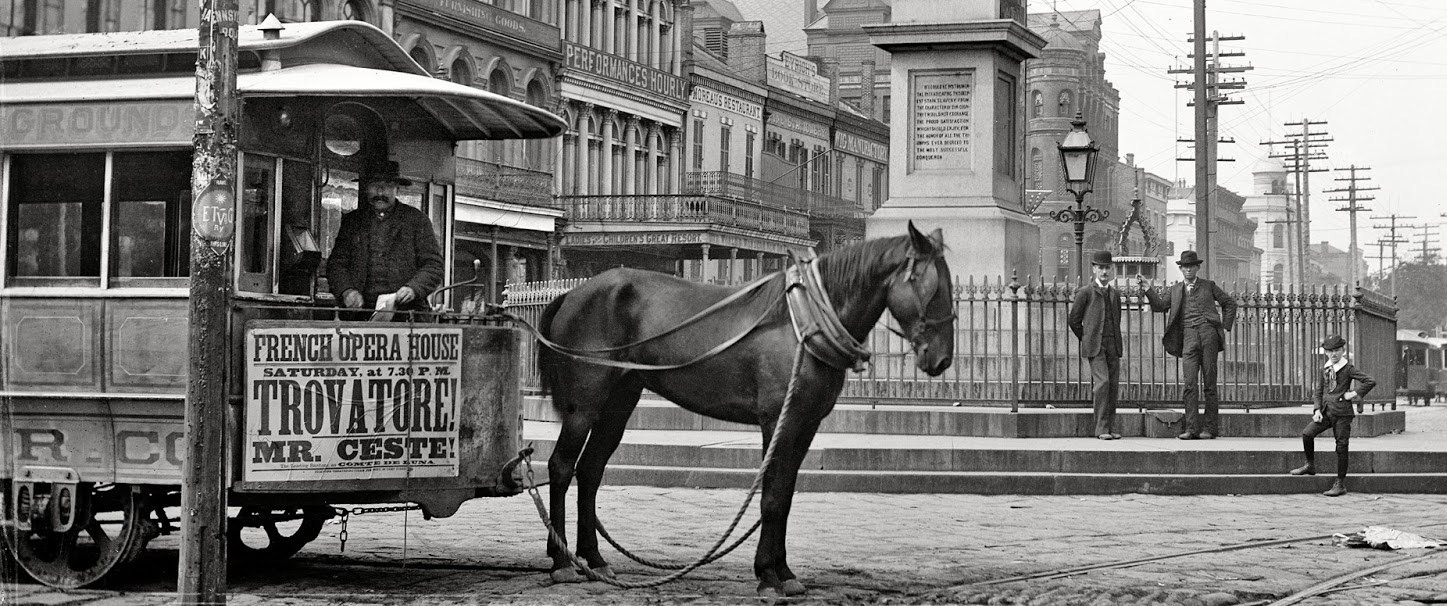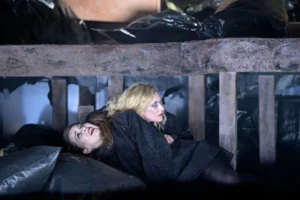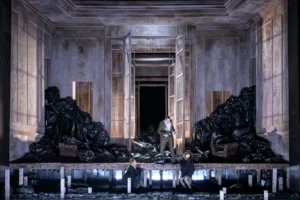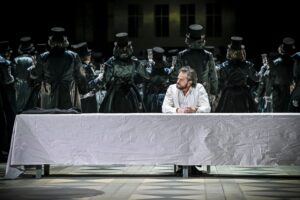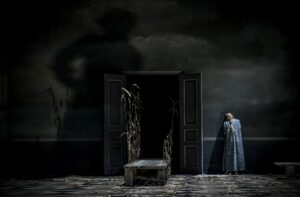As I wait anxiously, but also with hope, for the long-awaited change of the management of Teatr Wielki-Polish National Opera, I have been closely following the activities of our southern neighbours. In both Poland and Czechia the advocates of entrusting leadership positions in national institutions to local artists and managers are still going strong. This, however, is where the similarities end. The Teatr Wielki-Polish National Opera has long abandoned the model of a repertory theatre with a permanent ensemble of soloists – which, in my opinion, calls into question the legitimacy of referring to the company as the “National Opera”. At the two most important Czech companies – the National in Prague and the National in Brno – everything seems much more coherent. Both operate under the formula of a large organisational machine encompassing all types of theatre, managed by a general director supervising the artistic and administrative directors of the various “divisions”. In both cities the structure of the national theatre contains more than one operatic stage. The repertoire is huge and clearly focused on cultivating national works, but both the managements and permanent ensembles feature individuals from abroad – especially in Prague, where Filip Barankiewicz has been in charge of the Czech National Ballet since 2017 and Per Boye Hansen, the former artistic director of Den Norske Opera in Oslo, has been at the helm of the National Opera since 2019.
Such a national company – fulfilling its aesthetic, social and educational mission, and, at the same time, powered on a daily basis, and not once in a blue moon, by fresh ideas from outstanding artists and creators from around the world – is something I have long dreamed of in Poland. A company that is able to attract foreign visitors with its offerings and arouse the interest of international critics: in short, a “national” theatre in the most modern sense of the word, without complexes, promoting the culture of its country wisely and effectively, primarily in order to make it part of the international scene for good.
We can always dream, although we should be aware of the fact that it takes time and patience to accept such a state of affairs. Also in Prague, where the Norwegian management’s actions continue come up against resistance from audiences and the more conservative among the critics. The same was true of the January premiere of Cherubini’s Medea at the State Theatre, met with a rather cool reception from the audience, whose expectations were clearly at odds with the musical and theatrical reality of the performance.
Medea in Prague. Svetlana Aksenova in the title role, and Arnheiður Eiríksdóttir as Neris. Photo: Petr Neubert
Last year Warsaw’s Teatr Wielki-Polish National Opera missed an opportunity to present the work in a well-prepared original version. Médée, an opera or, more specifically, opéra comique with a French libretto by François-Benoît Hoffmann based on Euripides’ and Corneille’s tragedies, was written in 1797 and premiered on 13 March that year at the Théâtre Feydeau in Paris. The work, in which sung passages are interspersed with recited alexandrine lines, is classical in form and its musical structure stems from the spirit of Gluck’s reform. Yet when it comes to the way the eponymous character is treated, it is a good hundred years ahead of its day, foreshadowing the great operatic psychological dramas of Verdi, Wagner and even Richard Strauss. The title role, fiendishly difficult and full of technical pitfalls, was written for Julie-Angélique Scio, an outstanding soprano and great actress who put so much heart and enthusiasm into it that her health deteriorated and she soon died. The orchestral layer – rich in recurring motifs, dense, yet fluid in its narrative – was beyond the perceptual capabilities of many listeners at the time.
No wonder, then, that Médée soon disappeared from the reportoire. And, as is often the case, it began to be “improved”. Staged in a German translation in 1800, it was quite favourably received by the Berlin audiences. Two years later it reached Vienna with a libretto translated into Italian. In 1855 Franz Lachner threw out the spoken dialogues and replaced them with veritably Wagnerian recitatives, using an abridged Viennese version, but with a German libretto. In 1909 Carlo Zangarini translated Lachner’s version into Italian with a view to having the work premiered at La Scala. This is the form – most familiar to opera lovers today, yet woefully different from the original – in which Medea was “resurrected” in 1953 by Maria Callas, who, after her 1953 performance in Florence, sang it with variable success until the early 1960s.
This is also the version that was chosen in Prague – the idea was quite risky from the beginning given the inevitable comparisons with the vocal art of the Primadonna Assoluta. I have to admit that I, too, had my doubts about how Svetlana Aksenova would cope with this killer role – I heard her in 2018 in the role of Liza in The Queen of Spades and thought her voice was lovely but exceedingly lyrical, even girlish in expression. Since then it has become somewhat dull and less secure intonation-wise, and failed to develop in the upper range – it sounded relatively stable only in the middle. The singer clearly attempted to sing a role that lay beyond the limit of her abilities, and since she also lacked charisma, admirers of the divine Callas may have felt disappointed indeed. Much more impressive was Jana Sibera (Glauce), whose sensuous, sparkling soprano I was able to admire recently in Zemlinsky’s Kleider machen Leute. It was a mistake to entrust the role of Creonte to Marcell Bakonyi – his bass, undoubtedly well-controlled, proved too bright and not noble enough in tone for this royal part. The brightest points of the cast were Evan LeRoy Johnson, an excellent Giasone with a large, resonant, typical spinto tenor and an admirable ability to dynamically shape a phrase; and Arnheiður Eiríksdóttir as Neris – not only does the Icelandic artist possess a beautiful mezzo-soprano sparkling with harmonics, but she is also an excellent actress. I am not surprised that the audience appreciated the work of the chorus (prepared by Pavel Vaněk), but I do not quite understand why it was so unenthusiastic about the conductor responsible for the whole, Robert Jindra, who made every effort to bring out from this “Italianised” score as many elements as possible to demonstrate the uniqueness of Cherubini’s style – peculiarities of texture, dramatic tension lurking in almost every bar, evocative orchestral images foreshadowing Beethoven’s symphonic music, images in which the classical cohesion of form and sound gives way at times to feverish dialogues of the individual instrumental groups.
Arnheiður Eiríksdóttir, Marcell Bakonyi (Creonte), and Svetlana Aksenova. Photo: Petr Neubert
Nor did the Prague audiences like the staging, prepared by the German director Roland Schwab in collaboration with Paul Zoller (set design), Sabine Blickenstorfer (costumes) and Franck Evin (lighting). Schwab, who saved Bayreuth’s honour during the pandemic with his economical and functional concept of Tristan, approached Medea in a similar fashion – with surprisingly good results, in my opinion. Maintaining the classical unity of time and place, he played the whole thing out on two levels – Creonte’s austere palace, stripped of all ornaments, painted only by the light coming in through the high windows, and the dark world of Medea gnawing at it from below – damp, full of black rubbish bags, reeking of decay that would soon start seeping into the Corinthian residence. With each successive scene the palace gets darker and darker – until the house of the would-be newlyweds bursts into flames and Jason carries Glauce’s charred body out of the fire: so blinded by despair over the loss of his beloved that he completely forgets about his sons and only in the finale does he notice their corpses hanging from the ceiling. There was no intrusive psychologising in this staging, nor any attempt to place the classical tragedy in the current political context – the simple contemporary costume only served to make the message clear.
It will be interesting to see if the production will grow over time and get a more sympathetic audience. It fully deserves it in my opinion – compared to other Regietheater proposals, Schwab’s concepts seem exceptionally clear and singer-friendly. Stagings presented in an equally spare and modern stage language have long been a staple in Brno, where they are much better received by both the audiences and the critics. That is why the day after the Prague premiere I went to the Janáček Divadlo to see one of the most talked-about productions of the current season: Rusalka, directed by David Radok, whose earlier Salome made such an electrifying impression on me.
This time, however, I left the theatre a little confused. First, I was confused by Radok’s insufficiently clear declaration that he brought to Brno not so much a new stage concept for Dvorák’s masterpiece, but a reconstruction of the staging he directed in 2012 in Gothenburg with phenomenally beautiful decorations by Lars-Åke Thessmann that made a reference to paintings by the Danish artist Vilhelm Hammershøi, author of monochromatic interior views filled with intimate light. Radok, who was also listed in the programme of the Brno production as set designer, admitted that he drew inspiration from Thessmann’s work, but what I saw on the stage of the Janáčkovo Divadlo, however, was an almost literal reproduction of the visual setting from Göteborgsoperan, except perhaps for Act II, where Radok expanded the sets depth-wise, making full use of the space of the Brno theatre. The same is true of Zuzana Ježková’s costumes, which draw unambiguously on Ann-Mari Anttila’s designs – true, they sometimes differ from them in details of colour and cut, but I have seen revivals of legendary productions in which the costume designers dared to deviate much further from the original. I do not suspect the creators or the company’s management of bad intentions, but I would have preferred this kind of information to be clearly stated in the programmes and on the website – especially since this is about a production that caused quite a stir and not only in the small operatic world.
Rusalka in Brno. Peter Berger (Prince). Photo: Marek Olbrzymek
Secondly, Radok used the same procedure in Brno as he did earlier in Gothenburg: suggesting that Rusalka be read through Jungian archetypes and Freudian psychoanalysis, he decided to remove all folk and fairy tale motifs from the work, which in practice means reducing the cast by throwing out the characters of the Gamekeeper and Kitchen boy, making cuts in the role of Ježibaba and meddling with the rest of the text. Thus, roughly one-fifth of the music and the text was removed from the work. I can understand if the director would have been the first to come up with the idea of a Freudian-Ibsenian Rusalka, but productions staged in this spirit have been seen on the world’s stages for nearly half a century, and the creators of the most successful among them – primarily Pountney and McDonald – have used the “fairy tale element” contained in the opera to great advantage for their concepts. After all, Jaroslav Kvapil’s libretto had its sources of inspiration in both the fairy-tale-naturalistic plays of Hauptmann and the late, symbolist oeuvre of Ibsen. Kvapil tackled the theme of a clash of two world orders in his own plays. He was one of the pioneers of Czech modernist theatre. His Rusalka, masterfully constructed in terms of language and drama, is a masterpiece on its own, betraying an affinity with the oeuvre of Oscar Wilde. Dvořák treated it with almost pious reverence, as is evidenced by his correspondence with Kvapil. Radok, who is a Czech himself, saw only pessimism and decadence in it, completely ignoring the grotesque and black humour, so characteristic of Central European modernism.
Radok’s concept has many advocates, also among the lovers of Rusalka. I – paradoxically – found the narrative dragging on at times; it was monotonous, on one level of emotion, without moments of dramatic counterbalance, which in Kvapil and Dvořák’s work serve not only as interludes, but also as important commentaries that complete the context. Visually, however, it is a truly dazzling staging – a painting-like tale of a thousand shades of loneliness, emptiness and solitude, balancing on the border between two worlds that only seem to intermingle. Harbingers of misfortune are hiding everywhere. The reeds covering the edges of piers linking the indoors to the outdoors are yellowed already in Act I; the room is empty and grey, but in comparison with Act III, where the remains of fallen blades lie around the wet floor, it may indeed seem like cosy shelter. The castle garden is lit by chandeliers hanging under the black sky. Nothing is visible in their light: the weeding guests seem not to notice to Rusalka’s silent despair or Vodnik’s anguish, or what is going on between the Prince and the Foreign Princess. Radok clearly highlights the Wagnerian aspects of the story: the wood sprites’ banter with Vodnik, who is desperate for intimacy, brings to mind the beginning of Das Rheingold and Alberich’s humiliation; the cold and unapproachable Ježibaba has some traits of Erda; the Prince’s death and Rusalka’s return to the world of watery night resembles the finale of Tristan and Isolde.
Jana Šrejma Kačírková (Rusalka). Photo: Marek Olbrzymek
The performance I saw was excellent in musical terms as well. With her resonant, sparkling soprano Jana Šrejma Kačírková sang all the hope, pain and resignation of the eponymous heroine. Peter Berger once again demonstrated that in the fiendish role of the Prince – heroic, but requiring a large dose of lyricism and, above all, a very wide range – he has no rivals today. Jan Šťáva was a magnificent Vodnik. He is a typically “Czech” bass, impressive with the depth of his sound, phenomenal diction, lightness of phrasing and insight in creating this ambiguous character. Václava Krejčí, a singer with an assured, well-controlled mezzo-soprano, created a convincing portrayal of a cold and principled Ježibaba. I was slightly less impressed by Eliška Gattringerová as the Foreign Princess. Her soprano has a volume worthy of Brunhilde, but at times is too harsh, especially at the top of the range. Some extraordinary musicality was demonstrated by the other soloists: Doubravka Novotná, Ivana Pavlů and Monika Jägerová as the three Wood Sprites, and Tadeáš Hoza as the Hunter. The whole thing – including the company’s excellent chorus – was conducted by Marko Ivanović. His tempi were too steady for my taste at times, but he showed great attention to detail in this intimate, irresistibly sensual score.
I complained, I enthused and I hereby declare that this is a good sign. A real opera theatre is happening across Poland’s southern border. It is very active, and impresses with the breadth of its repertoire, stable musical level and courage in embarking on ambitious ventures that are not always fully successful. A theatre whose productions do not need to be ignored with embarrassment or praised in advance, because at this stage it can also face criticism. How I miss this every day – fortunately, Czechia is not far away.
Translated by: Anna Kijak
